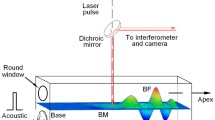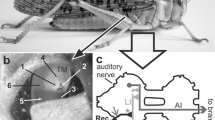Locusta migratoria L.
). The handling of living insects, the survival, and physiological response after treatment are described. We selectively interrupted the d-receptor of the tympanal organ, which is the receptor system responsible for the locust’s sensitivity in the high-frequency range (>10 kHz). The effects of the laser treatment were tested by determining hearing thresholds in electrophysiological recordings from the tympanal nerves. In agreement with the literature, the interruption of the d-receptors led to a significant shift towards higher values of the thresholds in the high-frequency range. Future perspectives and biological applications of UV-laser ablation are discussed.
Similar content being viewed by others
Author information
Authors and Affiliations
Additional information
Received: 10 Dezember 1998 / Accepted: 15 December 1998 / Published online: 24 February 1999
Rights and permissions
About this article
Cite this article
Fuhr, G., Ronacher, B., Krahe, R. et al. UV-laser ablation of sensory cells in living insects . Appl Phys A 68, 379–385 (1999). https://doi.org/10.1007/s003390050909
Issue Date:
DOI: https://doi.org/10.1007/s003390050909




